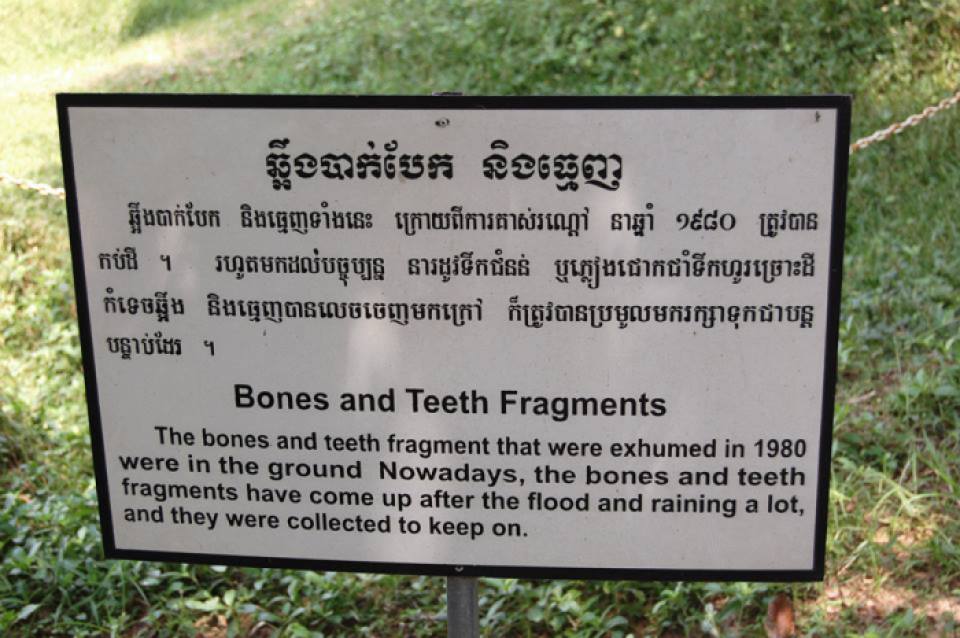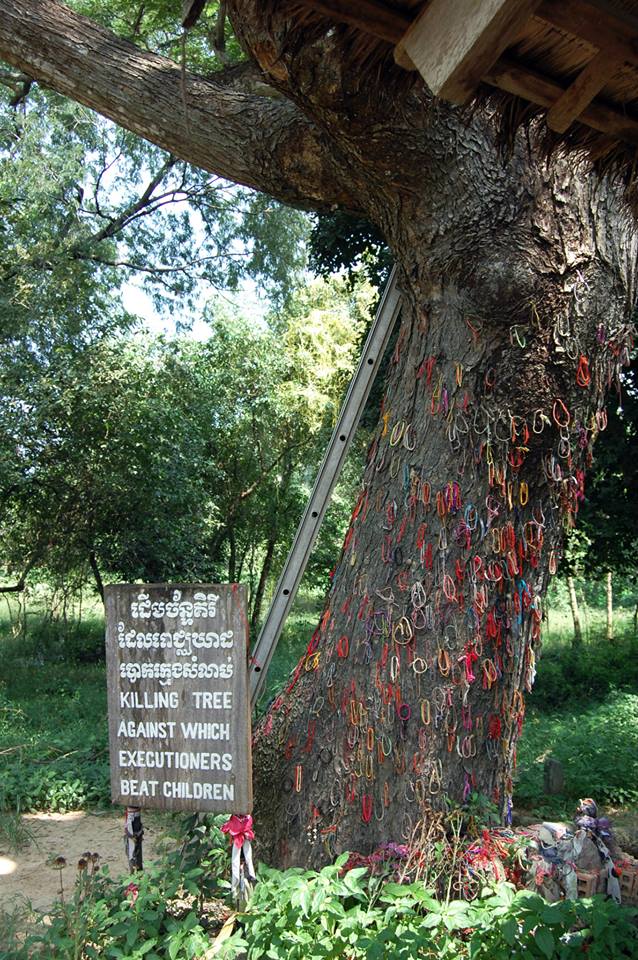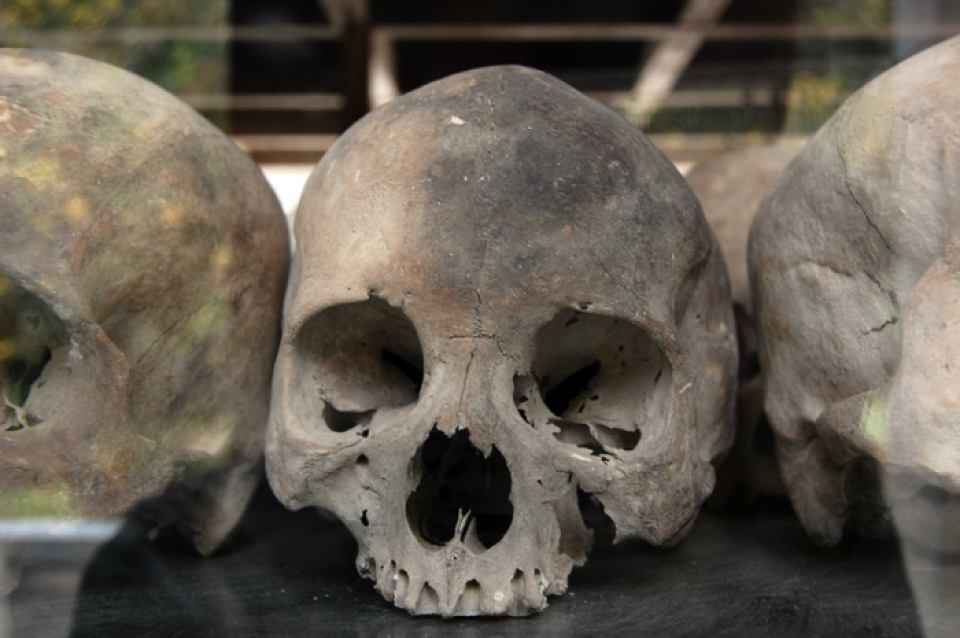Enjoying the Sun at the Cambodia Killing Fields
Last Updated on April 13, 2024 by Adam Watts
It was a glorious day of bright sunshine and fluffy blue clouds, and I was headed to the Killing Fields of Cambodia.
Locals relaxed inside their shaded moped tuk-tuks or stood smiling beside carts of ice-cold water and Coke; tourists meandered around the streets, cameras swinging around their necks; even the man in the hostel couldn’t have been any more helpful this morning.
All in all, I couldn’t have picked a better day to go visit a tree onto which babies’ heads were smashed and their bodies dumped into a pit.
I was visiting Chuong Ek, the most infamous of the Killing Fields in Cambodia, and I was excited. After visiting Auschwitz earlier in the year I’d discovered my love of Dark Tourism and was keen to experience more atrocities for myself, from the comfort of the future I hasten to add; I’m not going to try a homestay with Somali pirates anytime soon.
I grabbed a tuk-tuk driver who said he’d take me everywhere I needed to go for the entire day for $18. Once at Chuong Ek, he wandered off with the other tuk-tuk drivers and left me to explore the area for myself.
Unlike at Auschwitz, it wasn’t immediately apparent where I needed to go. There weren’t as many tourists and there weren’t long barbed-wire fences and ominous-looking buildings. There was an entrance where I picked up an audio tour (they were free) and set it playing, and was told to follow the path that meandered around some trees and then a little lake.
For those who don’t know, Cambodia was the home of the Khmer Rouge, who killed around 2 million people from 1975 to 1979. They were led by Pol Pot, not to be confused with Paul Potts, the former Carphone Warehouse manager turned opera singer, for whom there is no evidence of any genocidal tendencies. I’m glad we’ve cleared that up.
[Update: apparently quite a few people find this post by searching “paul potts killing fields” or “paul potts cambodia” so if that includes you, I hope the above paragraph cleared things up for you. You’re welcome.]
I stopped a little way along the first path, next to a little plaque in the ground that said it was Point 1. I was standing next to a patch of empty grass with a few other tourists.
The voice in my head (the audio guide, remember — I’m not crazy) told me there used to be a building here but it had since been demolished. It then gave me some exact numbers about the Khmer Rouge and their victims, then encouraged me to continue following the path. This continued for a while.
Occasionally there was a gazebo under which there was a rectangular patch of earth that was an open grave. A few such points mentioned that every now and then fragments of bone and pieces of cloth make their way to the surface, which I suspect was just a way of making us take an extra special interest in flat, grassy ground. And indeed a lot of tourists did wander around staring intently at the ground, like hungry chickens.
Then there was a sort of voluntary intermission. I could either continue obediently following the numbers, or I could take the long way and walk around the edge of the lake, listening to a few “survivor stories”, complete with violin accompaniment.
The “dead baby tree” as I’ll affectionately call it is the highlight (or lowlight depending on how you want to look at things) of Chuong Ek. It’s just a tree, yes, but uniquely among all other trees, it’s responsible for the death of hundreds, maybe thousands, of infant humans.
I mean, sure, the bastards who held the babies by their tiny feet and swung them brain-first into the bark are more responsible, but still, it’s not a tree I’d want to mess with.
Finally at Chuong Ek, there’s a Buddhist stupa, which contains over 5,000 human skulls to have a nosy at. You can’t see all of them as you can only see the first few “levels”, but if you stop and stare and think, it really hits home just how terrible Pol Pot (not Paul Potts, remember) and his crew were.
Just make sure that as you’re looking through the glass at the human remains, nobody sneaks up and rattles the glass and makes a skull move because that freaks you the fuck out.
And that concludes my whistle-stop tour of a site of genocide at which hundreds of thousands of people were killed! Have a nice day! Cheerio!
For an introduction to dark tourism, click here.










I hope to visit here when I go to Cambodia. My partner and friends find it terribly horrific that I like to visit places where people died. I too have an interest in Dark Tourism. Later this year I will visit Auschwitz and Warsaw Ghetto. There are so many places in the world tourists visit and it probably doesn’t cross their minds that hundreds of people died beneath their feet. Take Normandy for example or Vietnam….
Reblogged this on various life exploits.
I visited there as well. Cambodia struck me as a rather freaky place all in all. Didn’t pick up the audio guide though.
“Dead baby tree” was my favourite part. Let’s marry.